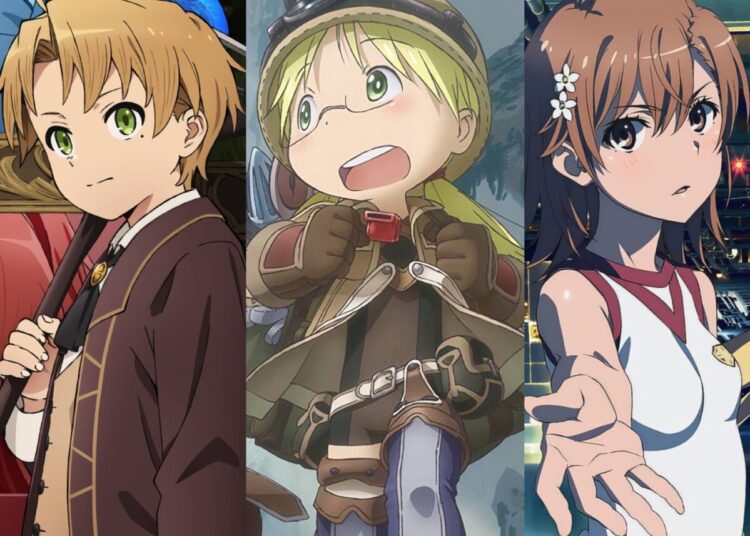Many people first experience Japan through its animation, which has been a staple of entertainment here since Astro Boy was first broadcast back in 1963. I remember being surprised at the oversized eyes in the shows I loved as a child — although in comparison, the eye-to-face area ratio is much higher now than in the old school shows of the 1970s. I was similarly surprised at the rainbow of hair colors found on most anime characters. Creating characters with hair in colors of green and blue and pink allows animation designers to be as expressive as possible and come up with characters who contrast sharply with the somewhat drab concrete-and-power-lines reality of modern Japan. There are subliminal messages embedded in the hair color choices, too. For example, red-haired characters are usually fiery and spirited, while the stereotypical refined girl from a wealthy family will often have blue hair. Black or brown are often used to represent the hair color of “Japanese” characters, who are more likely to be identified with by local viewers, and are generally more conservative (compare Amuro Rei to the flamboyant Char Aznable from the original Gundam series). While anime characters might sport bright shades of the rainbow on their heads, people in Japan don’t actually have such colorful hair, do they? The answer is yes: despite the inability of hair-dye companies like Gatsby to make colorful hair “cool” among young people, many older Japanese seem perfectly happy to wear blue, purple and pink tints in their hair. Why this fashion trend is limited to people aged 80 and older is a mystery to me.
I love to study the Meiji Restoration, an event that probably has no equal in the history of the rest of the world. During the Edo Period (1603-1867), the line of Tokugawa Shoguns ruled Japan and kept it closed to outsiders. This changed with the arrival of Admiral Perry and his Black Ships, who forced Japan to trade with the United States and the rest of the world. A movement of young revolutionaries who opposed any contact with foreigners rallied around the Emperor, traditionally a powerless figurehead, and sonno joi (son-NOH JOH-ee) was their famous slogan, meaning “Respect the Emperor, expel the foreign barbarians” (it’s one of our most popular T-shirts). As soon as they actually gained power, the leaders of the movement realized they couldn’t very well go along ignoring the rest of the world forever, so they started negotiating with foreign powers. This displeased Saigo Takamori, a powerful member of their group, and he rebelled against the new government (these were the events in The Last Samurai, if you saw it).
During this intense period of change, Japan had to make some interesting and difficult choices. First of all, the government had to eliminate the annual stipend that anyone in the old samurai class was entitled to, which was a major political issue back then — they mostly traded the stipends for government jobs. The government needed to do more to ensure that progress wasn’t erased by disgruntled anti-reformers, so in 1871 they abolished the old system of “han” domains in favor of the current network of 47 prefectures, organized along totally new lines and with all-new names. Because of this, every part of Japan has two names, its modern one and its old name, such as Kozuke for our prefecture of Gunma, Ezo for Hokkaido, and so on. (Can you imagine all of the U.S. states being erased and redrawn along alternate lines?) Another important event of the early Meiji Era was the Iwakura Mission, when many of the Founding Fathers of the Meiji Government such as Hirobumi Ito and Toshimichi Okubo — as famous as Benjamin Franklin and Paul Revere to the Japanese — toured the United States and Europe as Japan’s first official diplomatic contact with the outside world. They negotiated treaties and observed how advanced the rest of the world was technologically, and what they saw formed the basis for Japan’s long road to modernization.
(Small aside, I found a killer photo of Edo taken in 1865 or 1866, here. Is this not the coolest thing you’ve ever seen? A photograph of Tokyo from the Edo Period!)
J-List has long been a pioneer of PC dating-sim games, a fun genre of character- and story-based games for PCs in which you interact with cute anime girls as you move through the story, trying to find the keys to unlock their hearts. This year we released the first-ever yaoi PC dating-sim, Enzai – Falsely Accused, for the many fans on the other side of the aisle, and we’ve been really happy with the response we’ve gotten. Now we’re happy to announce that our second English-translated “BL” game is in stock and shipping, the long-awaited Absolute Obedience by Langmaor, a unique game set in a highly stylized version of post-war West Germany. Featuring a great game system with twelve chapters and the ability to play either as the dapper Louis Hardwich or his uncouth sidekick Kia WelBehenna, this is an outstanding title that anyone interested in the genre should pick up. Check it out now!















